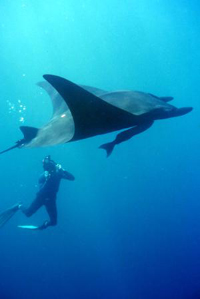Gulf of California
The Gulf of California (also known as the Sea of Cortez or Sea of Cortés; locally known in the Spanish language as Mar de Cortés or, much less frequently, Golfo de California) is a body of water that separates the Baja California Peninsula from the Mexican mainland. It is bordered by the states of Baja California, Baja California Sur, Sonora, and Sinaloa. The name "Gulf of California" predominates on most maps in English today. The name "Sea of Cortés" is the one preferred by most local residents.
It was named in honor of Spanish conquistador Hernán Cortés (or "Cortez") by Francisco de Ulloa in 1539. Ulloa originally believed that the gulf led to the mythical Strait of Anian, which connected the Pacific Ocean to the Atlantic Ocean.
Melchior Díaz made extensive explorations in the area in 1540, including surveying the Colorado River, which at that time flowed into the upper gulf.
The narrow sea is home to a unique and rich ecosystem. In addition to a wide range of endemic creatures, it hosts many migratory species, such as the humpback whale, California Gray Whale, manta ray and Leatherback Sea Turtle. This region has historically been a magnet for world class sport fishing activities, with a rich history of sporting world records.

Giant Pacific Manta Ray
The region also has a rich history as a commercial fishery. Some authors have reported witnessing tuna schools more than 100 miles (160 km) long in this region.
Today, the sea still attracts tourists from around the world, but the fishing resource is in serious decline. Efforts by the Mexican government to create conservation zones have been hampered by a lack of enforcement resources and a lack of political consensus. The thousands of miles of coastline are remote and difficult to police, and the commercial fishing industry is organized into politically powerful labor unions that have been slow to embrace strict conservation measures.
Sea of Cortés communities that are highly reliant on the sport fishing industry include Cabo San Lucas, La Paz, Loreto, Guaymas, and Mulegé. Ensenada, on Baja California's Pacific Ocean coast, and Mazatlán, on the Mexican mainland's Pacific coast, depend on the sagging commercial fishery.
All text is available under the terms of the GNU Free Documentation License.